NASCAR cuts the Sprint Cup ribbon at Kentucky Speedway....but just how safe is this track? Tony Stewart raises questions
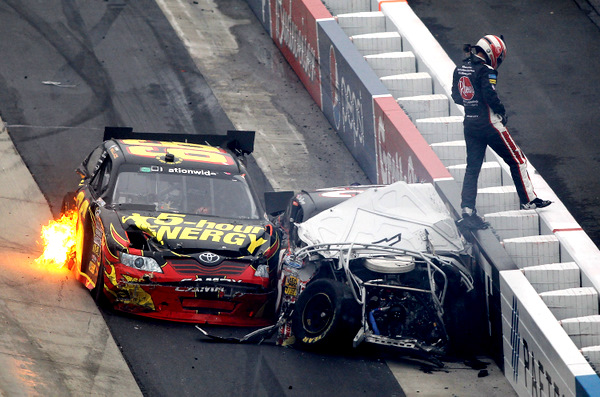
NASCAR's Safer barrier of softwalls works amazingly well, as Clint Bowyer, here, demonstrated at Dover, Del., a few weeks ago. (Photo: Getty Images for NASCAR)
(Updated)
By Mike Mulhern
mikemulhern.net
But it is a warning that also raises the question of why, since this track has been hosting NASCAR Truck and Nationwide tour events for some 10 years now, no driver or crew chief or car owner noticed the problem or raised the safety issue.
New inside concrete walls were installed since last summer's Nationwide race here, and those walls were moved closer to the racing surface. However those inside walls are not protected by the unique Safer barrier, which is one of the biggest safety improvements in racing history.
On top of that, the outside wall on the frontstretch trioval is likewise just hard concrete, without the Safer barrier.
Consider this: http://bit.ly/pgNBhX
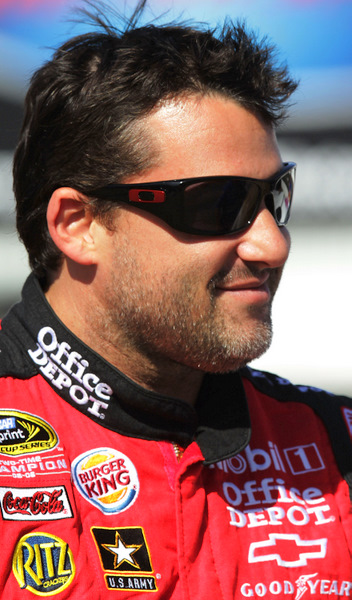
Tony Stewart: NASCAR should be insisting on tracks installing softwalls everywhere (Photo: Getty Images for NASCAR)
Bruton Smith, the new owner of the track, is hosting the Cup tour's first race here this weekend, part of a Truck-Nationwide-Cup triple-header. And he is in the process of major renovations, including new grandstands.
Smith plans to tear up this asphalt and lay down new asphalt before next summer's stop here. And part of such a repave involves removing and replacing Safer barriers.
By the way, the repave here, according to sources, will involve a major redesign, to make the track, particularly the corners and the corner entries, more like Texas Motor Speedway.
And presumably Safer barriers will be installed all the way around the track, inside walls as well as outside walls.
However this weekend the lack of Safer barriers everywhere raises a significant safety question.
"Every concrete wall needs a Safer barrier," Stewart says bluntly.
"They don't have enough SAFER barriers yet. Not near enough SAFER barriers for what we're doing here and how close the wall is to the race track. Hopefully none of us will have to test that out...
"By the time we come back here next year I'm sure there will be changes."
Has Stewart talked to NASCAR president Mike Helton about the issue? "This is the first time I've been on the track, today, so this is the first time I've seen it," Stewart replied. "I think they moved the wall since the last race; I don't remember it being this close to the track."
Gordon: "I was thinking, last weekend, after Richmond's announcement (of more Safer softwalls for the Sept. 10 race), 'I wonder what other tracks don't have Safer barriers?' And then we come here and I saw the inside walls….
"Hopefully that's the only time I notice it.
"I know they've put a lot of time, effort and money into getting this race track ready….and hopefully it's not an issue. We'll see.
"There are definitely some areas out there that could be addressed.
"Right now the way this track is, the inside is not much of an issue as it is at some other tracks.
"But we'll have to get through a race.
"Hopefully I'm not the crash-test dummy again."
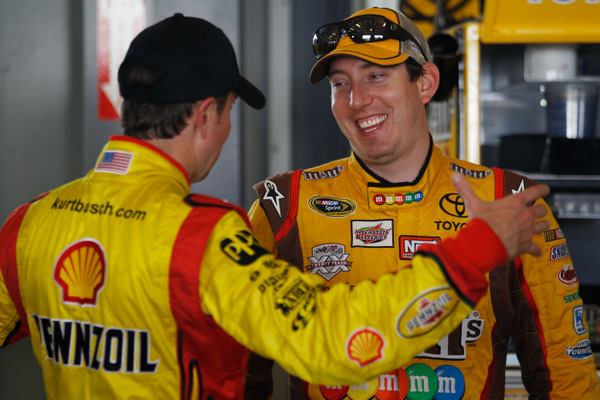
Kyle Busch (R) trades jokes with brother Kurt (Photo: Getty Images for NASCAR)
However Carl Edwards and Joey Logano have raced here for years. Why haven't they raised the safety issue?
And why hasn't Gordon himself raised the safety issue, in light of his bad crashes into hard concrete in recent years at Richmond and Las Vegas?
Las Vegas responded to Gordon's crash by immediately adding soft walls to the area in question. And Richmond officials just announced they too would be fixing the questioned walls at that track.
Part of the question here is the inside wall near the first turn, which was apparently redesigned since last summer and moved closer to the race track. It has no Safer barrier. While that part of any track is typically unlikely to be hit by a driver in a crash, Gordon has twice found the wrong mark.
Edwards' take? That yes the inside wall was moved out closer to the track, "and I would think that would make your impact shallower," Edwards says.
"If the track has the money to afford it, I'm for Safer barriers everywhere.
"But I don't even know where the Safer barriers are at this track."
David Ragan, winner at Daytona last weekend, says "You'd think at a track like this, when they're spending money renovating, that they'd put Safer barriers 100 percent all the way around.
"Now that you've brought it up, I'm going to look and see."
NASCAR's John Darby, Sprint Cup competition director, says since this is the first Cup weekend here, it's still a look-see situation in many respects.
"Obviously the track has done a lot of improving," Darby says. "And everything to my knowledge is that they will continue to do that.
"We're here; we'll look and see what we've got. And all the experts will come in and say 'Maybe you need this or that.' And I'm sure they'll move it forward, and we'll comply with all that."
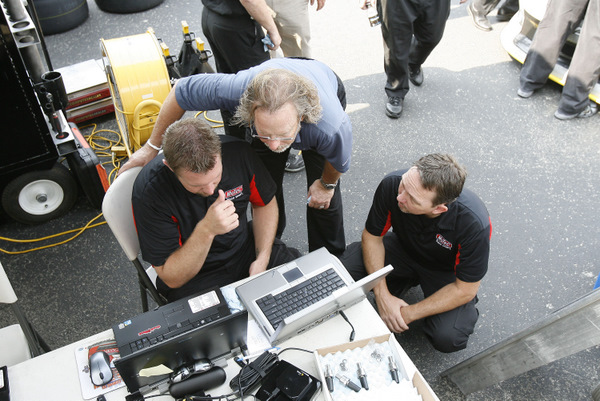
A great day at the track...if you love to read computers (Photo: Getty Images for NASCAR)
The softwalls controversy was the day's major hot button issue.
Otherwise, it was a day only geeky computer engineers and high-tech crew chiefs could love – a full, jammed day of data-acquisition testing here at Kentucky Speedway, the newest track on the Sprint Cup tour, and the first new stop for the sport in 10 years.
Among the day's fastest: Kyle Busch (178.849 mph), Paul Menard (177.643) and Carl Edwards (177.317)….through the first 5-1/2 hours of the endless practice session, an extra day thrown into the week's schedule because this is a new stop on the Cup tour and pre-race testing at Cup tracks has been banned for two years now.
Not that many of these guys really needed much practice to figure out how to get around this 1-1/2-mile track….because it was used for years as a major test track by Cup teams.
"It's good to be able to come to a track where you've never been to before, like this, because there's a whole lot we don't know," Jeff Burton says. "We're gathering a lot of data, a lot of information. And everybody is learning something different."
So the track is still bumpy, extremely bumpy down the frontstretch and into the first turn. And the tires are holding up well.
And now it's up to team engineers to spend a night digesting all the intricate data?
"Some will figure it out, and some won't," Burton added with a laugh.
The fastest drivers in Thursday's practice runs, of the 48 entered – though not in cars they will be running in Saturday night's 400, unless they need a backup – were Jimmie Johnson, Paul Menard, Travis Kvapil, and Kyle Busch. Five other drivers, Ricky Stenhouse, Aric Almirola, Mike Skinner, Austin Dillon and Sam Hornish, tested in separate cars with electronic fuel injection, a NASCAR test for the proposed changeover from the venerable carburetor to the passenger-car-standard EFI.
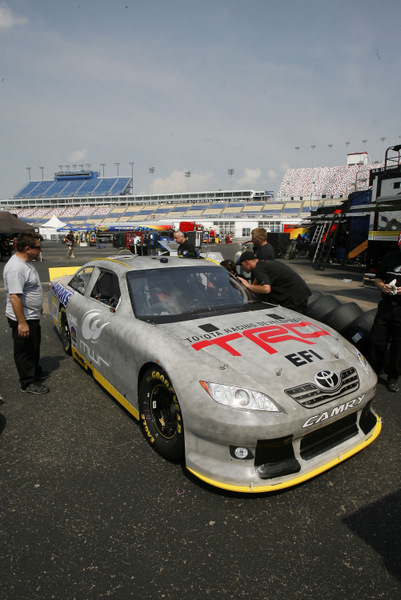
EFI -- electronic fuel injection. Instead of NASCAR's venerable engine carburetors. But is EFI too expensive? (Photo: Getty Images for NASCAR)
The question about EFI appears not so much the technical aspects but the economic aspects. NASCAR again Thursday brushed off questions about how much the units cost. However teams says that each unit will cost a team about $25,000 and that each single-car team will need five or six. And car owners say they expect to have to hire another at-track engineer to handle the systems.
That means the changeover from carburetors to EFI – which in effect is only a PR-cosmetic change, since carburetors do the job just fine, and for a very cheap price – could cost $200,000 per team or more.
In these economically-strapped times even mega-team owners like Jack Roush have raised the cost issue. (The NASCAR-mandated changeover this season from gasoline to gasoline with 15 percent corn-based ethanol has cost Roush an estimated $300,000 just for the new gas cans alone.)
How much control each team may have over the EFI air-fuel mixture, and how that may be adjusted at each track, appears up in the air.
ISC boss Lesa France Kennedy and NASCAR president Mike Helton (Photo: Getty Images for NASCAR)
Is the France family's International Speedway Corp. (ISCA) poised for a breakout? That's what one Wall Street analyst last week was saying.
However the company, whose stock has traded from $22.34 up to $32.32 over the past year, just announced its second quarter revenues – which missed Wall Street's predictions by a penny a share.
ISC's second quarter results: revenues down, but net income up – by cost cutting.
The ISC certainly hasn't been standing still lately:
-- a new track boss, Dennis Bickmeier, has been named to run Richmond International Raceway, replacing Doug Fritz;
-- repaving is underway at Phoenix International Raceway;
-- Kansas Speedway, which just received a second Cup weekend, is set to be repaved;
-- and California's Auto Club Speedway will next year play host to a fall Indy-car race, marking the return of that branch of the sport to the ISC calendar, after being bounced from every ISC track this season.
The company issued its fiscal second quarter results Thursday, and CEO Lesa France Kennedy reports "growth in operating income" for the first half of the year (ending May 31st).
However that was on decreased revenues – down because ISC dropped the spring Indy-car and Truck races at Kansas Speedway (to make room for the June 5th second Sprint Cup race).
Hence the boost in operating income comes from cutting costs.
"While the economy remains our biggest hurdle to admissions-related revenue growth," she says, "we feel confident that our commitment to improving the guest experience is positioning the Company for long-term growth."
The quick items:
-- total revenues for the second quarter were $138.8 million, compared to $142.2 million in the prior year period.
-- operating income increased to $24.1 million during the period, compared to $21.3 million in the second quarter of fiscal 2010 (remember, California 500 was moved from February/first quarter to March/second quarter, and Phoenix vice versa).
-- net income for the second quarter increased to $11.9 million, compared to net income of $10.3 million.
-- the Staten Island project is still on the books.
-- For the first six months, total revenues were $287.4 million, compared to $294.2 million in 2010; operating income for the six-month period increased to $63.4 million compared to $61.1 million; net income for the six months ended May 31, 2011 was $33.3 million, compared to a net income of $35.7 million in 2010.
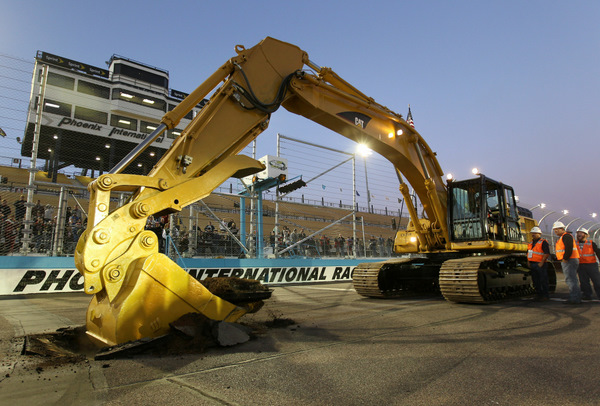
ISC's Phoenix repave, well underway: got to spend money to make money....maybe Bruton Smith needs to take a page from Lesa France Kennedy's new playbook (Photo: Getty Images for NASCAR)
© 2010-2011 www.mikemulhern.net All rights reserved.
Web site by www.webdesigncarolinas.com







notice how nascar lets five
notice how nascar lets five teams test efi 1 ford 1 dodge 1 toyota and as allways 2 chevys. can you say more data make for a good advantage to start out on top. nascar is a joke.
wow a picture of mike helton
wow a picture of mike helton with out rick hendrick or one of his drivers standing beside him. thats a first.
Reply to comment